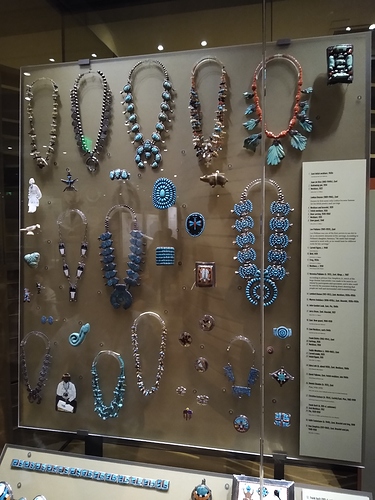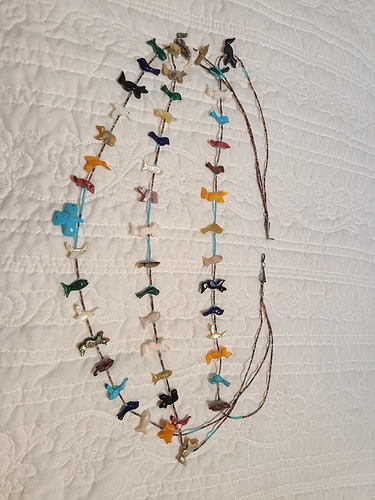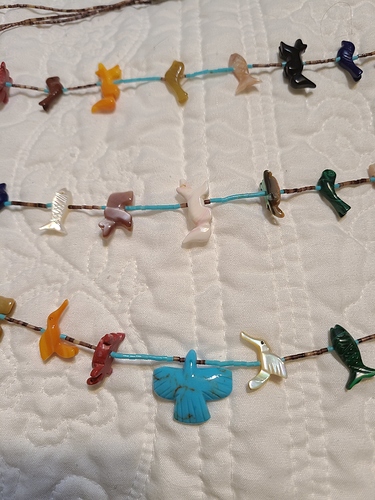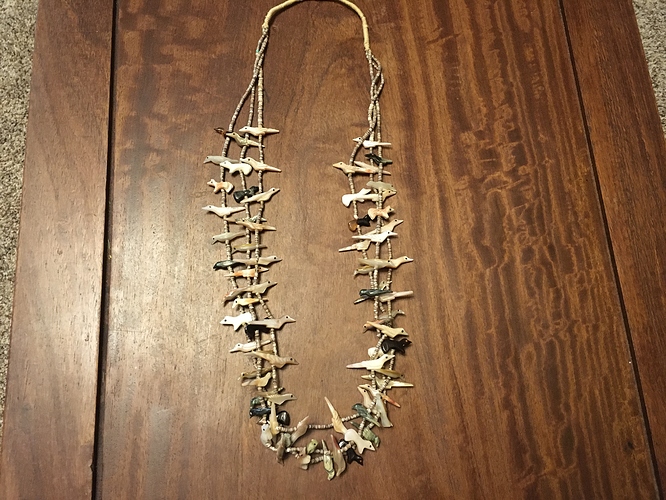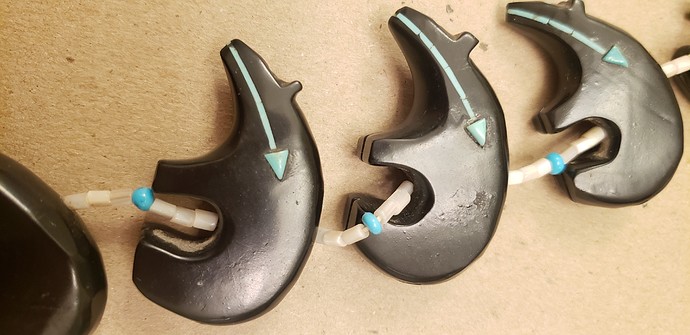Let me start by saying that I am only now just learning about Fetish/Heishe necklaces. I find that there is some much contradicting information from one website to another, one book to another, one person to another…
I was at the World renowned Heard Museum in Phoenix Arizona yesterday. I wish I had taken a better photo but this photo shows examples of everything you claim is fake. Spread Eagle wings, wrapped ends, “no” heishe between fetish, more than three strands. This would suggest that most all the fetish necklaces on display at the Heard Museum are fakes.
These pieces on display at the heard, are carved by the masters of fetish carving. When I say “the masters,” I mean that they are legends in their own right. I can see a Leekya Deyuse in your picture. It’s these designs that are copied and knocked off by the thousands both stateside, and the phillipines. It’s unlikely that you would just so happen to find a Leekya Deyuse for sale on Facebook marketplace or online, and they seller was totally unaware. No where did I ever suggest that THE HEARD has fake items on display. I promise you that the stacked fetish necklace you buy from wish.com couldn’t touch the quality of a stacked fetish made by old man Leekya.
I didn’t make up this information, I retrieved it from Keshi, who almost exclusively sells fetishes and other hand carved Zuni arts, and is widely regarded as a reliable source of information.
I received this as a lovely gift and I am just wondering about its origins. It has a center wing spread eagle so perhaps not zuni?
This style of necklace is often strung together by Natives using beads and components imported from overseas. NativeAmerican Handcrafted would probably be the most appropriate term to describe it
Thank you for your response!
This is a picture of a necklace that was my mothers. I believe she bought it during the early 60s. We traveled to Arizona and New Mexico to buy jewelry from artisans she had read about. Unfortunately I do not know who made this necklace. I am presuming from your post that this is an authentic necklace because it has the he/she stones in between the card animals. The animals are birds that do have further detail on them and bears mostly. I am going to be selling this so I want to make sure that it’s authentic before I do. It does have a wrapped cordate at the top rather than in class so I wasn’t sure how that impacted the necklace. With someone please be so kind as to offer me some opinions? I’m not very knowledgeable about this. Thank you!
Who made it. Yours is not an import. The imports tend to be angular and the ones carved by Zuni tend to be rounded. I just learned that the birds with the heads that are turned slightly to the right like some of yours are characteristic of the birds carved by George Chee Chee Haloo. $$$$ for starters - look him up, the galleries are selling his stuff for thousands. Bigbree43 has written up much info regarding fetish necklaces in an earlier post. Do not let this one go. Sometimes an artist will use fetishes from more than one carver, which makes it even more difficult. I’ll let the experts weigh in, though.
Can you post closer-up photos of the fetishes?
The cord wrapped part at the back of the necklace was referred to in an article I read over ten years ago as a “squaw wrap” by a Navajo craftswoman. This length of very neatly wound cord was to protect the skin at the back of a woman’s neck from scratching & chafing when wearing a heavy necklace: as such, it was supposed to be a sign of meticulous and careful work, certainly not a rough finish or anything that would cheapen a necklace.
Welcome to the board. This is a great place to learn as I have been doing for several years now. One of the things I’ve learned is “squaw wrap” seems to be considered an outdated, negative term in the Native American communities. As with he/her/they it is sometimes hard to keep up with what is currently ‘politically correct’. I would definitely agree with you that the wrap is a sign of a better necklace!
Yes, I fully get your point. I was a bit uncomfortable quoting it & I appreciate the sensibilities of First Nation people: I had only seen the term a few times many years ago and would hate to demean or upset anyone. However the technique I think is a very good one for making the wearer of a piece more comfortable. I have a Navajo jasper, turquoise & silver necklace with the stringing wire caught in a crimp fastening and a sharp wire end that has stopped me wearing it for the last few years! I may restring it myself one of these days.
I was given this necklace, (edited to add the following since it was commented that the odds of authenticity are low due to the value : a close friend passed away and she gifted me this in a box full of Native American and sterling jewelry. There were several authentic squashblossom necklaces, turquoise jewelry and a multitude of sterling pieces. The squash blossoms have been authenticated. But I didn’t ask about this one. It seems crass to say this but she was financially blessed, and she enjoyed collecting jewelry, clothes, etc.) I can’t find much info about it online. Would this be considered a Fetish necklace? What are the odds of it being authentic, or is it most likely a replica? Any info that I can use as a starting point to do some more research would be much appreciated 
The first place to start is to consider who gave it to you and what the likely situation would be. Is that person in a position to have likely (1) owned an expensive authentic Zuni necklace, roughly $800-1300 in today’s money, and (2) gifted you an item of that value? This simple exercise in logic is usually a clear path to the answer. Not asking for an answer here, in a public forum, but something to mull.
The odds of a randomly acquired fetish necklace–meaning you don’t know its source–being a valuable authentic piece are statistically way against it being so, but the odds aren’t zero. I’ll leave it to others to evaluate this piece.
It is a interesting necklace. What are the fetishes made out of? Are they wooden? I have never seen wooden fetishes. But I am just learning myself.
By Navajo Artist: Neil Thomas Navajo Fetish Beaded Single Strand Necklace | Amazon.com Wow amazing work!
Very nicely executed and no question it is hand done as no 2 are quite the same.
To Bigbree43, Interesting because the outstretched wings are seen on Neil Thomas works, Unless they are incorrectly listed? Neil thomas fetish necklace | Etsy
I believe that the bears are jet. They a certainly not wood.
